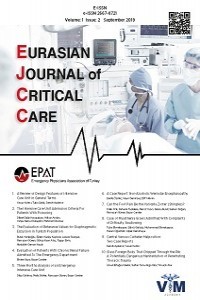The Role of C-RP / Albumin Ratio in The Diagnosis of Stroke and an Overview of the Factors Affecting Hemispheres
The Role of C-RP / Albumin Ratio in The Diagnosis of Stroke and an Overview of the Factors Affecting Hemispheres
C-RP/Albumin value, Diabetes, Hypertension Left Hemisphere Infarction, Stroke,
___
- 1. Yaltkaya K, Balkan S, Oguz Y. Cerebrovascular Diseases. Textbook of Neurology. Ankara Palme. 1st. Ed. 1996. 179-215.
- 2. Adams Jr HP, Bendixen BH, Kapelle J, Biller J, Love BB, Gordon DL, et al. The TOAST investigators. Classification of subtypes of acute ischemic stroke. Definition for use in multicenter clinical trial. Stroke.1993;24:35-41
- 3. Goldstein LB, Adams R, Alberts MJ. Primary Prevention of Ischemic Stroke: A Guideline From the American Heart Association/ American Stroke. Stroke 2006; 37: 1583-1633.
- 4. Janghorbani M. Prospective study of type 1 and type 2 diabetes and risk of stroke subtypes: the Nurses’ Health Study. Diabetes care 30.7.2007; 1730-1735.
- 5. Beckman JA, Creager MA, Libby P: Diabetes and atherosclerosis: epidemiology, pathophysiology and management. JAMA. 2002; 287:2570–2581
- 6. Lippincott, Williams & Wilkins Primer: The Essentials of High Blood Pressure. 1st. Ed. Baltimore: 1999; 239
- 7. Prineas J, Marshall J. Hypertension and Stroke. British Medicine Journal, 1966; 1 (5478), 14.
- 8. Vasan RS, Beiser A, Seshadri S. Residual lifetime risk for developing hypertension in middle-aged women and men: the Framingham Heart Study. JAMA. 2002; 287: 1003–1010
- 9. SHEP Cooperative Research Group. Prevention of stroke by antihypertensive drug treatment in older persons with isolated systolic hypertension: final results of the Systolic Hypertension in the Elderly Program (SHEP). JAMA. 1991; 265: 3255–3264.
- 10. Sanossian N, Ovbiagele B. Multimodality stroke prevention. Neurologist. 2006;12(1): 14-31.
- 11. Balkan S, Topçuoğlu M.A. İnme ve Hipertansiyon. Turkiye Klinikleri J Neu. 2004;2(1):41-7.
- 12. Kocer B. Hypertension and Brain. Turkiye Klinikleri J Cardiol-Special Topics. 2009;2(4):53-8
- 13. Min J, Farooq M.U, Greenberg E, Aloka F, Bhatt A, Kassab M et al. Cardiac dysfunction after left permanent cerebral focal ischemia: the brain and heart connection. Stroke. 2009; 40(7):2560–3
- 14. Zia E, Hedblad B, Pessah-Rasmussen H, Berglund G, Janzon L, Engström G. Blood pressure in relation to the incidence of cerebral infarction and intracerebral hemorrhage: hypertensive hemorrhage: debated nomenclature is still relevant. Stroke. 2007; 38(10), 2681-2685.
- 15. Yamori Y, Horie R, Handa H, Sato M, Fukase M. Pathogenic similarity of strokes in stroke-prone spontaneously hypertensive rats and humans. Stroke. 1976;7(1):46-53
- 16. Cermak J, Key NS, Bach RR, Balla J, Jacob HS, Vercellotti GM. C-reactive protein induces human peripheral blood monocytes to synthesize tissue factor. Blood. 1993; 82: 513-20.
- 17. Chang CY, Chen JY, Ke D, Hu ML. Plasma levels of lipophilic antioxidant vitamins in acute ischemic stroke patients: correlation to inflammation markers and neurological deficits. Nutrition. 2005; 21: 987-93.
- 18. Belayev L, Saul I, Busto R. Albumin treatment reduces neurological deficit and protects blood-brain barrier integrity after acute intracortical hematoma in the rat. Stroke. 2005; 36:326-331.
- 19. Gotlie AI, Langille BL. The role of rheology in atherosclerotic coronary artery disease. In: Fuster V, Ross R, Topol EJ, ed. Atherosclerosis and Coronary Artery Disease. Philadelphia, Pa: Lippincott-Raven Publishers. 1996. 595–606.
- 20. Ku DN, Giddens DP, Zarins CK, Glagov S. Pulsatile flow and atherosclerosis in the human carotid bifurcation: positive correlation between plaque location and low oscillating shear stress. Arteriosclerosis. 1985; 5:293–302.
- 21. Amarenco P, Duyckaerts C, Tzourio C, Henin D, Bousser MG, Hauw JJ. The prevalence of ulcerated plaques in the aortic arch in patients with stroke. N Engl J Med. 1992; 326:221– 225.
- 22. Snell R.S. Cerebral Dominance. Clinical Neuroanatomy for Medical School Students. Nobel Publisher. Istanbul. 2000. 276–289.
- 23. Pedersen PM, Jorgensen HS, Nakayama H, Raaschou HO. Hemineglect in acute stroke-incidence and prognostic implications. The Copenhagen stroke study. Am J Phys MedRehabil. 1997;76:122-7
- Başlangıç: 2019
- Yayıncı: Acil Tıp Uzmanları Derneği
Effect of Using Metoclopramide and Ondansetron in the Emergency Department on the Treatment Duration
Oya GÜVEN, Özlem TATAROĞLU, Dilay SATILMIŞ, Mehmet ERDOĞAN
Paraoxonase Activity In Patients With Chronic Obstructive Pulmonary Disease
Kerim YEŞİLDAĞ, Turgut TEKE, Sami ERDEM
Özlem BİLİR, Gökhan ERSUNAN, Asım KALKAN
Covid-19 Pandemic, Restrictions and Rhabdomyolysis
Bedia GULEN, Bahadir TASLİDERE, Yasin UGUR, Ayse Busra OZCAN, Ertan SONMEZ
Management of a Case of Gangrenous Cholecystitis Detected in the Emergency Department
Pre Hospital Cutting-Punching Tool Injuries At Emergency Health Services: Konya Sample
Hasan KÜÇÜKKENDİRCİ, Serap BATI
Serhat ÖRÜN, Efe Mehmet Can KIRCA
Posterior Reversible Encephalopathy Case In Emergency Department
Dilber ÜÇÖZ KOCAŞABAN, Sertaç GÜLER
